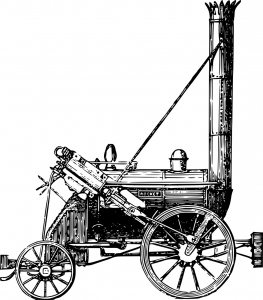
The Aeolipile was the world’s first rotating steam engine, or more technically correct, a steam reaction turbine. It was devised by the great Heron of Alexandria in the1st Century AD. A sphere mounted on a spindle with two opposing outlet pipes for steam that propelled the sphere round on an axle.
In more recent times:
Thomas Newcomen (1664– 1729) was an English inventor who created the atmospheric engine, the first practical fuel-burning engine in 1712 for the purpose of lifting water out of a tin mine. He was an ironmonger by trade and a Baptist lay preacher by calling!
Steam power then really took off with improvements made by James Watt in 1778. The Watt steam engine improved the efficiency of steam engines considerably. His engines could be smaller and use less coal. Watt’s steam engine design incorporated two of his own inventions: the separate condenser (1765) and the parallel motion (1784). By the early 1800s, Watt steam engines were used in factories throughout England.
Then an Englishman Richard Trevithick launched the first practical steam locomotive in 1804, it averaged less than 10 mph.
George Stephenson (1781-1848) was the son of a mechanic who operated a Newcomen atmospheric-steam engine that was used to pump out a coal mine at Newcastle upon Tyne.
George himself learnt to manage the primitive steam engines employed in mines, and worked in a number of different coalmines in the northeast of England and in Scotland.
In 1814, Stephenson constructed his first locomotive, ‘Blucher’, for hauling coal at Killingworth Colliery near Newcastle.
In 1821, Stephenson was appointed engineer for the construction of the Stockton and Darlington railway. It opened in 1825 and was the first public railway. The following year Stephenson was made engineer for the Liverpool to Manchester Railway. In October 1829, the railway’s owners staged a competition at Rainhill to find the best kind of locomotive to pull heavy loads over long distances. Thousands came to watch. Stephenson’s locomotive ‘Rocket’ which he built with his son, Robert, was the winner, achieving a record speed of 36 miles per hour.
The opening of the Stockton to Darlington railway and the success of ‘Rocket’ stimulated the laying of railway lines and the construction of locomotives all over the UK. Stephenson became engineer on a number of these projects and was also consulted on the development of railways in Belgium and Spain.
It is inspiring these pioneering innovations happened here on this small island by ordinary people!
Hope you have a good month
All the best
Mike
Quotations:
“The innovation point is the pivotal moment when talented and motivated people seek the opportunity to act on their ideas and dreams.” – W. Arthur Porter
“Learn from the mistakes of others. You can never live long enough to make them all yourself.” – Groucho Marx
ps If you have enjoyed this blog please feel free to pass on to others

